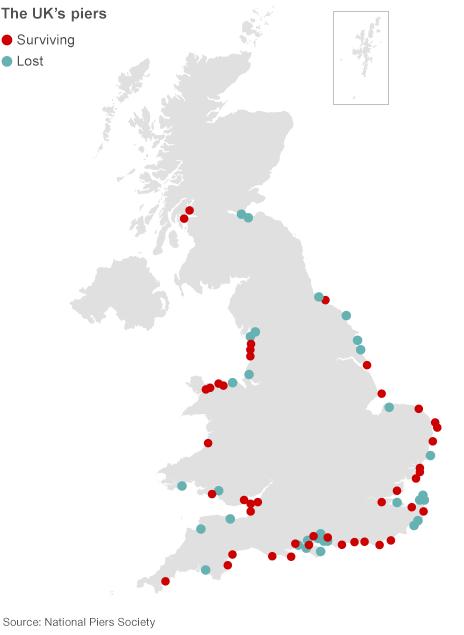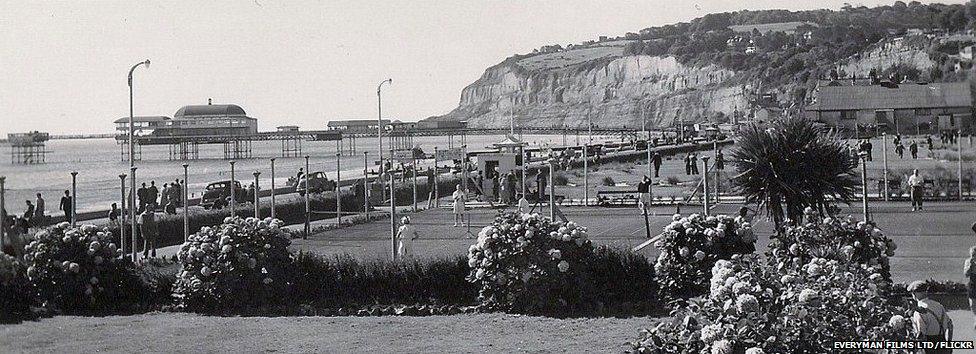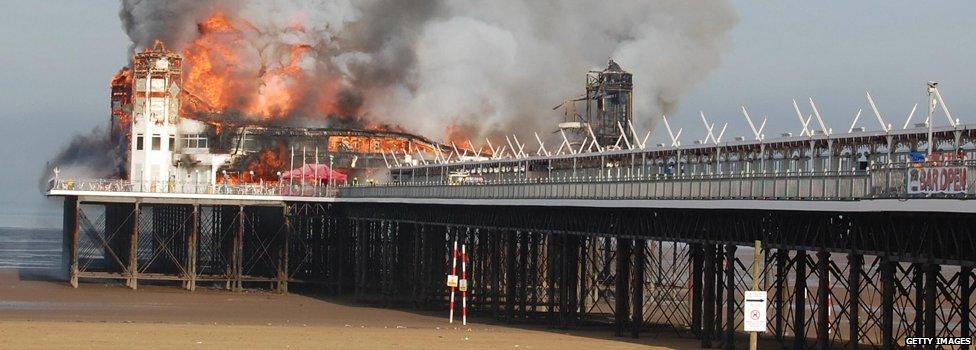What happens to burned piers?
- Published

Brighton's West Pier has suffered two fires
A fire has destroyed much of the 144-year-old Eastbourne Pier. How can such buildings make a comeback, asks Justin Parkinson.
The timing couldn't be worse. Crowds gathered to watch as the main building Eastbourne's pier was destroyed by fire, putting it out of action for the peak summer season. But the East Sussex town's MP has already promised efforts to get it going in some capacity by next summer.
"It's important that we save these structures," says Anthony Wills, of the National Piers Society. "The thing with Eastbourne is to get it going as soon as possible to ensure the revenue comes in to pay for the necessary work."
This doesn't always happen. If not maintained, the weather gradually destroys the building, much of which is made of wood, making costs ever-more prohibitive.

Brighton's West Pier closed in 1975 after suffering storm damage and has never reopened. It suffered two fires and is now little more than a metal frame, following several failed schemes to raise money for renovation. A 170m viewing tower, external is being built on the site of the original entrance. The West Pier Trust, external, which owns the land, will take an income and says it will look at whether a "contemporary pier" is feasible.

Shanklin Pier was destroyed in the storm of 1987 and was never rebuilt (below)

Some have simply disappeared, external. Morecambe Central Pier was demolished in 1992 and Dover Promenade Pier went in 1927, after repair costs became too great. The great storm of 1987 put paid to Shanklin Pier's future.
But there is some hope. Hastings Pier is undergoing a £14m rebuild after it was destroyed by a fire in 2010, with help from Lottery funding.
Southend Pier, which measures 1.34 miles in length, is now home to a cultural centre, including a theatre and artists' workshops. It underwent repair work following a fire in 2005.

Weston-super-Mare's Grand Pier caught fire in 2008 and re-opened in 2010 (below)


The pavilion of Weston-super-Mare's pier was destroyed in a fire in 2008. It was rebuilt at a cost of £52m, but increased costs mean users are now charged £1 to visit. Weston was, according to Wills, the last of the UK's great pleasure piers to be built, opening in 1905.
Most of the structures were built as landing points for steam ships, the theatres and pleasure arcades springing up to maximise the commercial space and attract seaside daytrippers.
"That made them more viable, as they had a dual use," says Wills, co-author of British Seaside Piers. "The modern concern is more about preserving the ones that are left than building new ones."

Colwyn Bay Victoria Pier opened in 1900 and closed in 2011 due to the dangerous state of its structure

The future of Colwyn Bay Pier is uncertain, with campaigners looking to save £15m to preserve it. Bognor's pier lost its famous Birdman contest to nearby Worthing, after damage made it too short to reach deep enough into the English Channel to host the event.
Last week, Ryde Pier, on the Isle of Wight celebrated its 200th anniversary. It is recognised as the first "great" British seaside pier, as opposed to jetties or causeways.
More than 50 remain across the UK, external, as a testament to almost a century of building work that's unlikely to be repeated.

Send us your pictures
Send your pictures and videos to yourpics@bbc.co.uk or text them to 61124 (UK) or +44 7624 800 100 (International).
If you have a large file you can upload here, external.
If you prefer tweet @bbcnewsmagazine, external including #VintagePiers.

Subscribe to the BBC News Magazine's email newsletter to get articles sent to your inbox.